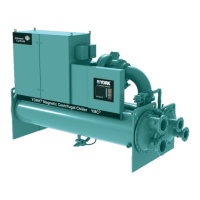JOHNSON CONTROLS
37
SECTION 3 - INSTALLATION
FORM 160.84-N1
ISSUE DATE: 11/22/2016
3
Stop Valves
Stop valves may be provided (by others) in the evapora-
tor and condenser water piping adjacent to the unit to
facilitate maintenance. Thermometer wells and pressure
taps should be provided (by others) in the piping as close
to the unit as possible to facilitate operating check.
Flow Switches
Thermal type water flow switches are factory mount-
ed in the chilled and condensed water nozzles and are
factory wired to the OptiView™ Control Panel. These
solid-state flow sensors have a small internal heating
element and use the cooling effect of the flowing fluid
to sense when flow has been established.
Waterbox Drain And Vent Valves
Drain and vent valves (by others) should be installed
in the connections provided in the evaporator and con-
denser liquid heads. These connections may be piped
to drain if desired. They will assist in proper fill and
vent of the chiller waterside prior to starting pumps to
ensure no voids exist that could cause damage from a
water slug.
Checking Piping Circuits And Venting Air
After the water piping is completed, but before any
water box insulation is applied. Tighten and torque to
maintain between 30 and 60 ft. lbs. (41 and 81 N·m)
the nuts on the liquid head flanges. Gasket shrinkage
and handling during transit cause nuts to loosen. If wa-
ter pressure is applied before tightening is done, the
gaskets may be damaged and have to be replaced. Fill
the chilled and condenser water circuits, operate the
pumps manually and carefully check the evaporator
and condenser water heads and piping for leaks. Repair
leaks as necessary.
Before initial operation of the unit both water circuits
should be thoroughly vented of all air at the high points.
Chilled Water
Foreign objects which could lodge in, or block flow
through, the evaporator and condenser tubes must be
kept out of the water circuit. All water piping must be
cleaned or flushed before being connected to the chill-
er pumps, or other equipment.
Permanent strainers (supplied by others) are required
in both the evaporator and condenser water circuits to
protect the chiller as well as the pumps, tower spray noz-
zles, chilled water coils and controls, etc. The strainer
must be installed in the entering chilled water and con-
denser liquid line, upstream and near to the chiller.
Water piping circuits should be arranged to avoid water
voids to the chiller, and should be controlled as neces-
sary to avoid rapid flow transients.
If pumps discharge through the chiller, the strainer
may be located upstream from pumps to protect both
pump and chiller. (Piping between strainer, pump and
chiller must be very carefully cleaned before start-up.)
If pumps are remotely installed from chiller, strainers
should be located directly upstream of the chiller.
Condenser Water Circuit
For proper operation of the unit, condenser refrigerant
pressure must be maintained above evaporator pressure.
If operating conditions will fulfill this requirement, no at-
tempt should be made to control condenser water temper-
ature by means of automatic valves, cycling of the cool-
ing tower fan, or other means, since chillers are designed
to function satisfactorily and efficiently when condenser
water is allowed to seek its own temperature level at re-
duced loads and off-peak seasons of the year. However, if
it is possible for the entering condenser water temperature
to go below the required minimum, condenser water tem-
perature must be maintained equal to or slightly higher
than the required minimum. Refer to the YMC
2
Engineer-
ing Guide (Form 160.84-EG1) for required minimum
Condenser and Evaporator temperatures. Refer to Figure
8 for typical water piping schematic.

